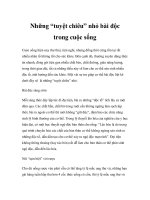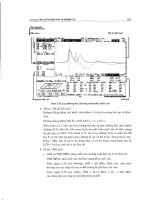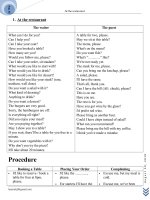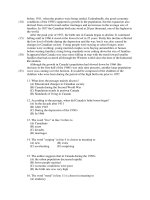Phân tích bài đọc trong toiec 8 potx
Bạn đang xem bản rút gọn của tài liệu. Xem và tải ngay bản đầy đủ của tài liệu tại đây (42.59 KB, 6 trang )
from a rain forest. While every species is different from every other species, their
(20) genetic makeup constrains them to be insects and to share similar characteristics with
750,000 species of insects. If basic, broad categories such as phyla and classes are
given more emphasis than differentiating between species, then the greatest diversity of
life is unquestionably the sea. Nearly every major type of plant and animal has some
representation there.
(25) To appreciate fully the diversity and abundance of life in the sea, it helps to think
small. Every spoonful of ocean water contains life, on the order of 100 to 100,000
bacterial cells plus assorted microscopic plants and animals, including larvae of
organisms ranging from sponges and corals to starfish and clams and much more.
31. What is the main point of the passage?
(A) Humans are destroying thousands of species.
(B) There are thousands of insect species.
(C) The sea is even richer in life than the rain forests.
(D) Coral reefs are similar to rain forests.
32. The word "appreciation" in line 2 is closest in meaning to
(A) ignorance
(B) recognition
(C) tolerance
(D) forgiveness
33. Why does the author compare rain forests and coral reefs(lines 4-7) ?
(A) They are approximately the same size.
(B) They share many similar species.
(C) Most of their inhabitants require water.
(D) Both have many different forms of life.
34. The word "bias" in line 9 is closest in meaning to
(A) concern
(B) disadvantage
(C) attitude
(D) prejudice
35. The passage suggests that most rain forest species are
(A) insects
(B) bacteria
(C) mammals
(D) birds
36. The word "there" in line 24 refers to
(A) the sea
(B) the rain forests
(C) a tree
(D) the Earth's surface
37. The author argues that there is more diversity of life in the sea than in the
rain forests because
(A) more phyla and classes of life are represented in the sea
(B) there are too many insects to make meaningful distinctions
(C) many insect species are too small to divide into categories
(D) marine life-forms reproduce at a faster rate
38. Which of the following is NOT mentioned as an example of microscopic sea life?
(A) Sponges
(B) Coral
(C) Starfish
(D) Shrimp
39. Which of the following conclusions is supported by the passage?
(A) Ocean life is highly adaptive.
(B) More attention needs to be paid to preserving ocean species and habitats.
(C) Ocean life is primarily composed of plants.
(D) The sea is highly resistant to the damage done by pollutants.
Questions 40-50
What geologists call the Basin and Range Province in the United States roughly
coincides in its northern portions with the geographic province known as the Great
Basin. The Great Basin is hemmed in on the west by the Sierra Nevada and on the east
Line by the Rocky Mountains; it has no outlet to the sea. The prevailing winds in the Great
(5) Basin are from the west. Warm, moist air from the Pacific Ocean is forced upward as it
crosses the Sierra Nevada. At the higher altitudes it cools and the moisture it carries is
precipitated as rain or snow on the western slopes of the mountains. That which
reaches the Basin is air wrung dry of moisture. What little water falls there as rain or
snow, mostly in the winter months, evaporates on the broad, flat desert floors. It is,
(10) therefore, an environment in which organisms battle for survival. Along the rare
watercourses, cottonwoods and willows eke out a sparse existence. In the upland
ranges, piñon pines and junipers struggle to hold their own.
But the Great Basin has not always been so arid. Many of its dry, closed depressions
were once filled with water. Owens Valley, Panamint Valley, and Death Valley were
(15) once a string of interconnected lakes. The two largest of the ancient lakes of the Great
Basin were Lake Lahontan and Lake Bonneville. The Great Salt Lake is all that
remains of the latter, and Pyramid Lake is one of the last briny remnants of the former.
There seem to have been several periods within the last tens of thousands of
years when water accumulated in these basins. The rise and fall of the lakes were
(20) undoubtedly linked to the advances and retreats of the great ice sheets that covered
much of the northern part of the North American continent during those times. Climatic
changes during the Ice Ages sometimes brought cooler, wetter weather to midlatitude
deserts worldwide, including those of the Great Basin. The broken valleys of the Great
Basin provided ready receptacles for this moisture.
40. What is the geographical relationship between the Basin and Range
Province and the Great Basin?
(A) The Great Basin is west of the Basin and Range Province.
(B) The Great Basin is larger than the Basin and Range Province
(C) The Great Basin is in the northern part of the Basin and Range Province.
(D) The Great Basin is mountainous ; the Basin and Range Province is flat desert.
41. According to the passage, what does the Great Basin lack?
(A) Snow
(B) Dry air
(C) Winds from the west
(D) Access to the ocean
42. The word "prevailing" in line 4 is closest in meaning to
(A) most frequent (B) occasional
(C) gentle (D) most dangerous
43. It can be inferred that the climate in the Great Basin is dry because
(A) the weather patterns are so turbulent
(B) the altitude prevents precipitation
(C) the winds are not strong enough to carry moisture
(D) precipitation falls in the nearby mountains
44. The word "it" in line 5 refers to
(A) Pacific Ocean
(B) air
(C) west
(D) the Great Basin
45. Why does the author mention cottonwoods and willows in line 11?
(A) To demonstrate that certain trees require a lit of water
(B) To give examples of trees that are able to survive in a difficult environment
(C) To show the beauty of the landscape of the Great Basin
(D) To assert that there are more living organisms in the Great Basin than there
used to be
46. Why does the author mention Owens Valley, Panamint Valley, and Death Valley
in the second paragraph?
(A) To explain their geographical formation
(B) To give examples of depressions that once contained water
(C) To compare the characteristics of the valleys with the characteristics of the lakes
(D) To explain what the Great Basin is like today
47. The words "the former" in line 17 refer to
(A) Lake Bonneville
(B) Lake Lahontan
(C) the Great Salt Lake
(D) Pyramid Lake
48. The word "accumulated" in line 19 is closest in meaning to
(A) dried
(B) flooded
(C) collected
(D) evaporated
49. According to the passage, the Ice Ages often brought about
(A) desert formation
(B) warmer climates
(C) broken valleys
(D) wetter weather
50. Where in the passage does the author explain how lakes probably formed
in the Great Basin?
(A) Lines 6-7
(B) Lines 10-11
(C) Lines 13-14
(D) Lines 21-24
Test 9
Questions 1-12
Before the 1500's, the western plains of North America were dominated by farmers.
One group, the Mandans, lived in the upper Missouri River country, primarily in
present-day North Dakota. They had large villages of houses built close together. The
Line tight arrangement enabled the Mandans to protect themselves more easily from the
(5) attacks of others who might seek to obtain some of the food these highly capable
farmers stored from one year to the next.
The women had primary responsibility for the fields. They had to excercise
considerable skill to produce the desired results, for their northern location meant
fleeting growing seasons. Winter often lingered ; autumn could be ushered in by
(10) severe frost. For good measure, during the spring and summer, drought, heat, hail,
grasshoppers, and other frustrations might await the wary grower.
Under such conditions, Mandan women had to grow maize capable of weathering
adversity. They began as early as it appeared feasible to do so in the spring, clearing
the land, using fire to clear stubble from the fields and then planting. From this point
(15) until the first green corn could be harvested, the crop required labor and vigilance.
Harvesting proceeded in two stages. In August the Mandans picked a smaller
amount of the crop before it had matured fully. This green corn was boiled, dried, and
shelled, with some of the maize slated for immediate consumption and the rest stored
in animal-skin bags. Later in the fall, the people picked the rest of the corn. They saved
(20) the best of the harvest for seeds or for trade, with the remainder eaten right away or
stored for later use in underground reserves. With appropriate banking of the extra
food, the Mandans protected themselves against the disaster of crop failure and
accompanying hunger.
The women planted another staple, squash, about the first of June, and harvested it
(25) near the time of the green corn harvest. After they picked it, they sliced it, dried it, and
strung the slices before they stored them. Once again, they saved the seed from the best
of the year's crop. The Mandans also grew sunflowers and tobacco ; the latter was the
particular task of the older men.
1. What is the main topic of the passage ?
(A) The agricultural activities of a North American Society
(B) Various ways corn can be used
(C) The problems encountered by farmers who specialize in growing one crop
(A) Weather conditions on the western plains
2. The Mandans built their houses close together in order to
(A) guard their supplies of food
(B) protect themselves against the weather
(C) allow more room for growing corn
(A) share farming implements
3. The word "enabled" in line 4 is closest in meaning to
(A) covered
(B) reminded
(C) helped
(A) isolated
4. The word "considerable" in line 8 is closest in meaning to
(A) planning (B) much
(C) physical (A) new
5. Why does the author believe that the Mandans were skilled farmers ?
(A) They developed effective fertilizers.
(B) They developed new varieties of corn.
(C) They could grow crops in most types of soil.
(A) They could grow crops despite adverse weather.
6. The word "consumption" in line 18 is closest in meaning to
(A) decay (B) planting
(C) eating (A) conversion
7. Which of the following processes does the author imply was done by both
men and women ?
(A) Clearing fields
(B) Planting corn
(C) Harvesting corn
(A) Harvesting squash
8. The word "disaster" in line 22 is closest in meaning to
(A) control
(B) catastrophe
(C) avoidance
(A) history
9. According to the passage, the Mandans preserved their food by
(A) smoking
(B) drying
(C) freezing
(A) salting
10. The word "it" in line 25 refers to
(A) June
(B) corn
(C) time
(A) squash
11. Which of the following crops was cultivated primarily by men ?
(A) Corn
(B) Squash
(C) Sunflower
(A) Tobacco
12. Throughout the passage, the author implies that the Mandans
(A) planned for the future
(B) valued individuality
(C) were open to strangers
(A) were very adventurous
Questions 13-21
The elements other than hydrogen and helium exist in such small quantities that it is
accurate to say that the universe is somewhat more than 25 percent helium by weight
and somewhat less than 75 percent hydrogen.
Line Astronomers have measured the abundance of helium throughout our galaxy and in
(5) other galaxies as well. Helium has been found in old stars, in relatively young ones, in
interstellar gas, and in the distant objects known as quasars. Helium nuclei have also
been found to be constituents of cosmic rays that fall on the earth (cosmic "rays" are
not really a form of radiation; they consist of rapidly moving particles of numerous
different kinds). It doesn't seem to make very much difference where the helium is
(10) found. Its relative abundance never seems to vary much. In some places, there may be
slightly more of it ; in others, slightly less, but the ratio of helium to hydrogen nuclei
always remains about the same.
Helium is created in stars. In fact, nuclear reactions that convert hydrogen to helium









